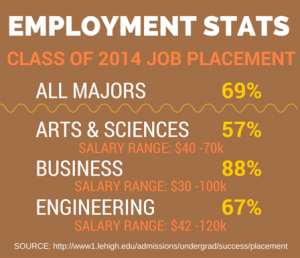With every graduating class comes another set of salary and job placement statistics to be added to Lehigh’s records. Pamphlets of numbers and percentages are sent out to parents and distributed to students from the career center and its counselors.
How are these numbers produced and what factors are considered in obtaining these averages?
Rich Freed, the director of employer outreach and operations in the Center for Career and Professional Development, explained the data collection process and how special situations are taken into consideration.
The process begins in March with a surveying of seniors, and continues for about six months. Another survey is taken in May, followed by the surveying of companies that commonly attend Lehigh job fairs to see if they hired any of the university’s students.
Another survey is emailed to the graduates in July, a paper mail survey is sent out to alumni’s last known addresses in November, and career counselors hold a phone campaign to call the students who have yet to respond to the data collection.
Lastly, counselors turn to social media such as Facebook and LinkedIn to fill in the blanks of missing information. Although this sort of data collection does not include salary information, it helps with job placement reports.
After all the data is collected it’s time to sort through it and, according to Freed, “clean it up.”
“We look at both extremes, if there is something really really high, or really really low, we take it out,” he said.
For example, C.J. McCollum, who was a journalism major, earns $2.52 million a year as a guard for the Portland Trail Blazers. He is considered to be an outlier, as his salary does not compare to that of the entry-level writing jobs that most journalism majors take after graduation.
This sorting through data helps to ensure that the statistics are as accurate as possible and reveal the general patterns displayed by the numbers.
According to career placement statistics for the class of 2014, 57 percent of the College of Arts and Sciences, 88 percent of the College of Business and Economics and 67 percent of the College of Engineering and Applied Science graduates are employed.

(Klaudia Jazwinska/Made with Canva)
However, students in the College of Arts and Sciences and Engineering more commonly seek post-graduate options, with 29 percent and 22 percent attending graduate school, respectively. Only 6 percent of the College of Business and Economics attend graduate school.
The top five employers for the class of 2014 were Ernst & Young, PricewaterhouseCoopers, IBM Corporation, KPMG and JPMorgan Chase & Co.
Along with employment, salary ranges vary as well — the highest mean starting salary for the College of Arts and Sciences in 2014 was $52,750, whereas the highest was $81,750 for the College of Business and Economics and $69,000 for the College of Engineering and Applied Science.
On average, any career stemming from the computer science and engineering majors tend to be the highest in terms of initial salary offers, whereas, those from the liberal arts tend to be on the lower side. However, according to Freed, this is a pattern that is seen around the country, not just at Lehigh.
On the other hand, wage gaps, such as the differences between male and female salaries, isn’t something that Career Services can say they notice regularly when students get their job offers. Freed said that the gender wage gaps can be attributed to a man being more likely to counteroffer.
“Male students, when they get that initial offer, tend to be a little bit more willing to negotiate, where female students will get the offer and just say, ‘OK yeah, that’s a good offer,’ and accept it,” Freed said.
These counteroffers may be accepted when the student has already interned for a company or is able to make a legitimate argument that they are worth the pay bump. It’s usually small, but over time, with annual salary increases that extra bit of money can exponentially increase, causing the wage gap evident in statistics.
According to Freed, about 80 percent of students who graduate Lehigh respond to their post-graduation surveys, compared to the 60 percent that respond in most schools nationally. Because of this, Lehigh is confident in the accuracy of their post-graduation statistics, as well as the trends that they notice.
“On average our salaries tend to be 10 to 15 percent higher in terms of starting salaries besides engineering,” Freed said.
Freed believes that this success is due to several factors including reputation and alumni networking opportunities.





Comment policy
Comments posted to The Brown and White website are reviewed by a moderator before being approved. Incendiary speech or harassing language, including comments targeted at individuals, may be deemed unacceptable and not published. Spam and other soliciting will also be declined.
The Brown and White also reserves the right to not publish entirely anonymous comments.